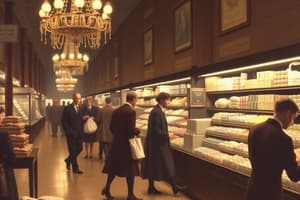Podcast
Questions and Answers
What effect did the use of credit have on the economy in the 1920s?
What effect did the use of credit have on the economy in the 1920s?
It made the economy weaker.
How did consumers weaken the economy in the late 1920s?
How did consumers weaken the economy in the late 1920s?
Consumers bought too many goods they could not afford.
Which statement best explains how farming affected the economic slowdown that led to the Great Depression?
Which statement best explains how farming affected the economic slowdown that led to the Great Depression?
Even though prices and demand were falling, production increased.
What is consumerism?
What is consumerism?
Which industry boosted consumerism in the 1920s, feeding economic growth?
Which industry boosted consumerism in the 1920s, feeding economic growth?
Who was Herbert Hoover?
Who was Herbert Hoover?
About how many people moved away from the Great Plains states during the Depression?
About how many people moved away from the Great Plains states during the Depression?
What happened after the stock market crash?
What happened after the stock market crash?
Which of the following is implied by significant population growth on the Great Plains between 1880 and 1930?
Which of the following is implied by significant population growth on the Great Plains between 1880 and 1930?
Before running for president in 1932, Franklin D. Roosevelt had been:
Before running for president in 1932, Franklin D. Roosevelt had been:
Which of the following pieces of legislation was also known as the Wagner Act?
Which of the following pieces of legislation was also known as the Wagner Act?
A current federal program from the New Deal that is directly related to the banking industry is the:
A current federal program from the New Deal that is directly related to the banking industry is the:
Why did many conservatives disagree with New Deal economic policies?
Why did many conservatives disagree with New Deal economic policies?
President Franklin Roosevelt's judicial reform bill would have allowed him to:
President Franklin Roosevelt's judicial reform bill would have allowed him to:
Which of the following oversaw the Federal One project in the 1930s?
Which of the following oversaw the Federal One project in the 1930s?
Which of the following would have most likely occurred if Franklin Roosevelt's judicial reform bill had become law?
Which of the following would have most likely occurred if Franklin Roosevelt's judicial reform bill had become law?
Why did President Roosevelt need to create a Second New Deal?
Why did President Roosevelt need to create a Second New Deal?
Unlike liberal critics of Roosevelt's New Deal, conservative critics:
Unlike liberal critics of Roosevelt's New Deal, conservative critics:
What precedents set by the New Deal have been put into play during periods of recession?
What precedents set by the New Deal have been put into play during periods of recession?
How did the Second New Deal create a way for workers to exercise their rights in the workplace?
How did the Second New Deal create a way for workers to exercise their rights in the workplace?
How did the Supreme Court frustrate Roosevelt's New Deal legislation?
How did the Supreme Court frustrate Roosevelt's New Deal legislation?
Flashcards are hidden until you start studying
Study Notes
Economic Context of the 1920s and Great Depression
- The reliance on credit in the 1920s weakened the American economy.
- Late 1920s consumer behavior contributed to economic decline as many purchased goods they could not afford.
- Agricultural production increased despite falling prices and demand, exacerbating the economic slowdown preceding the Great Depression.
Consumerism and Economic Growth
- Consumerism is characterized by the desire and act of acquiring new products.
- Advertising played a significant role in driving consumerism and supporting economic growth during the 1920s.
Key Figures and Demographics
- Herbert Hoover served as the U.S. President at the onset of the Great Depression.
- Approximately 2.5 million people migrated away from the Great Plains states during the economic downturn.
Reactions to Economic Crises
- Post-stock market crash, widespread panic led Americans to withdraw their money from banks.
- Significant population growth in the Great Plains from 1880 to 1930 indicated extensive land clearing for agriculture.
Franklin D. Roosevelt and the New Deal
- Franklin D. Roosevelt was previously the governor of New York before becoming President in 1932.
- The Wagner Act is officially known as the National Labor Relations Act, reinforcing labor rights.
- The Federal Deposit Insurance Corporation (FDIC) was established as part of the New Deal, directly impacting the banking sector.
- Conservatives opposed New Deal measures due to their belief in balanced budgets and minimal federal regulation.
Judicial Reforms and Government Power
- Roosevelt proposed a judicial reform bill allowing the appointment of up to six additional Supreme Court justices, which would increase executive power.
- The Works Progress Administration oversaw the Federal One project during the 1930s.
Continued Economic Challenges
- The Second New Deal was introduced due to ongoing economic struggles including high unemployment and poverty levels.
- Unlike liberal critics, conservative critics of the New Deal expressed concern over excessive government expansion.
- New Deal programs set precedents for financial aid during recessions, offering support to the unemployed.
Labor Rights and Supreme Court Challenges
- The National Labor Relations Act of 1935 strengthened workers' rights in the workplace.
- The Supreme Court posed challenges to New Deal legislation, declaring several parts unconstitutional, creating obstacles for Roosevelt's initiatives.
Studying That Suits You
Use AI to generate personalized quizzes and flashcards to suit your learning preferences.




